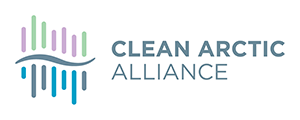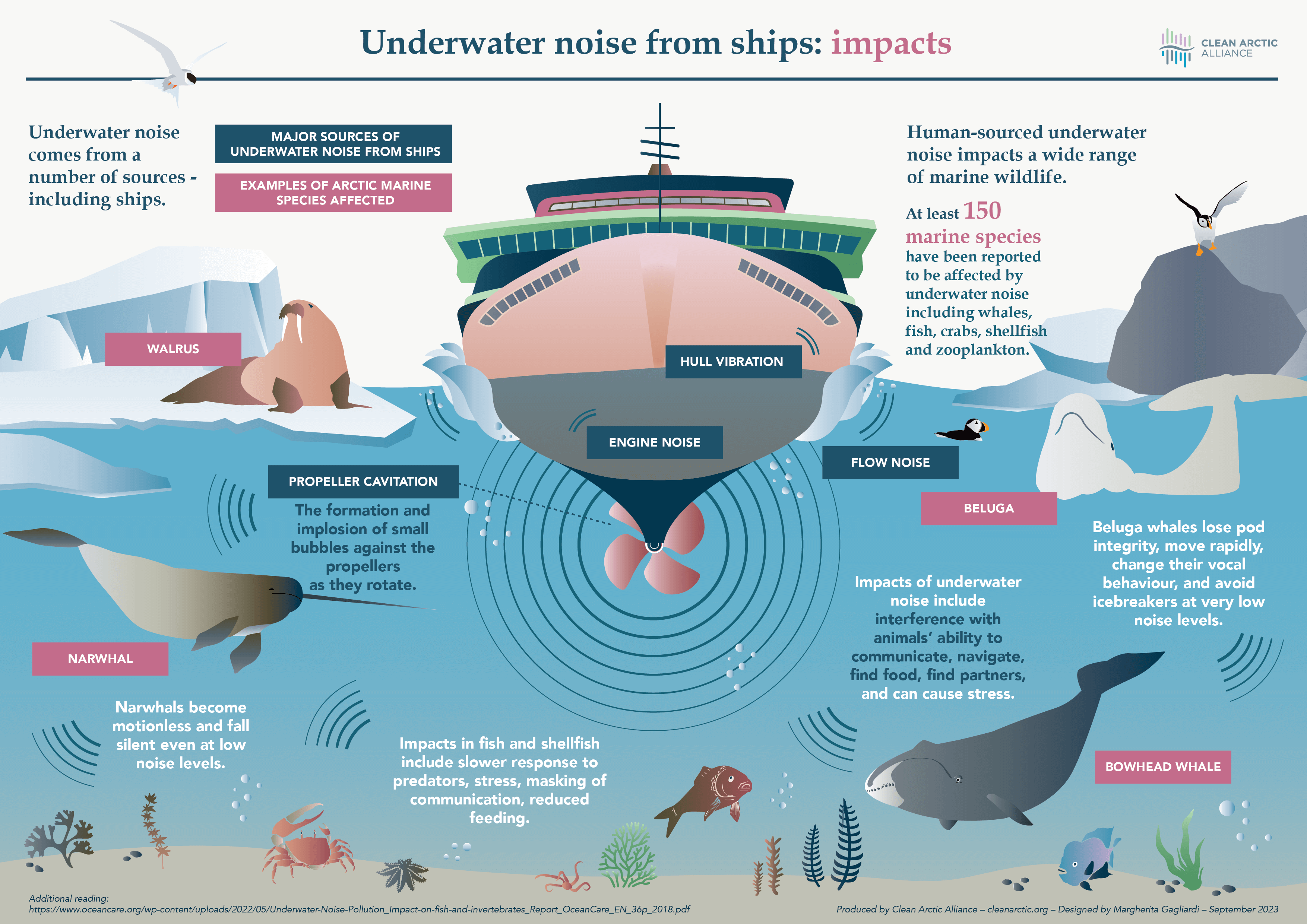London, 21 January 2022:- As a meeting of the International Maritime Organization’s Sub-Committee on Ship Design and Construction (SDC 8) closed today in London, the Clean Arctic Alliance welcomed the meeting’s recognition that the non-mandatory nature of the current eight-year-old IMO guidelines on underwater noise pollution from ships is a key barrier to their implementation, and called on the IMO to develop mandatory measures to reduce the impact of underwater noise on marine wildlife, including whales, dolphins and fish [1].
“While the Clean Arctic Alliance is pleased that SDC 8 has identified the non-mandatory nature of the current guidelines on underwater noise as a key barrier to their implementation, the IMO must now urgently develop global mandatory measures to reduce the impacts of underwater noise pollution on the health of marine wildlife, including whales, dolphins and fish”, said Dr Sian Prior, Lead Advisor to the Clean Arctic Alliance.
“The non-mandatory nature of the current guidelines, which have not been updated since 2014, also appear to have led to a de-prioritisation by the shipping sector – and this has resulted in increasing noise levels in the ocean, including the Arctic, where underwater noise from ships has a much greater impact”, she added.
““It is likely that there will be some solutions which will have co-benefits with other areas of IMO’s regulatory responsibilities, in particular efforts to address climate emissions, but only if the rules are stringent enough to trigger the necessary changes in behaviour needed to reduce emissions and underwater noise,” said Sarah Bobbe, Arctic Program Manager of Ocean Conservancy.
“The inclusion of the need to develop numerical targets and thresholds in the workplan put in place during the meeting is important. This workplan must now be delivered, as a matter of urgency”, said Bobbe.
“Ultimately, the IMO must agree to the development of mandatory measures so that the overall failure to reduce underwater noise is addressed globally,” concluded Dr Prior. “In addition to global measures, even more stringent regional measures to reduce acoustic pollution from vessels in areas such as the Arctic will be necessary. The Arctic is a special case for underwater noise because of how sound propagates over long distances and how it can impact marine life and Inuit communities who depend on wildlife and the sea for livelihoods and culture.”
ENDS
Contacts:
Dave Walsh, Clean Arctic Alliance Communications Advisor [email protected] +34 691 826 764
About Underwater Noise:
For many marine organisms sound is the most important means of communication. Under water, vision is very restricted and without good hearing ability, elementary functions such as navigating, finding prey and partners can be hampered. This is of particular importance for marine mammals, and also for fish and even invertebrates.
The Arctic has been almost free of anthropogenic (human-sourced) sound for a long time, but with increased human activity, the Arctic Ocean is becoming more noisy every year. An important source of continuous noise is shipping, more specifically the propeller and the engine. Since shipping has increased substantially during the last couple of decades, underwater noise is becoming an increasing problem, contributing to serious impact on the Arctic ecosystem.
“According to a study by Transport Canada, the World Maritime University and WWF the existing guidelines have not been effective in reducing underwater noise, namely because of their voluntary, non-regulatory nature. Research from the Arctic Council has recently shown that Arctic underwater noise has significantly increased over the past few years. Ship traffic is also increasing in the Arctic, and given the unique special Arctic environment, underwater noise from ships has a much higher impact than in other parts of the global ocean.
The most important source of continuous underwater noise in shipping is cavitation, or production of vacuum bubbles by propellers. The noise produced by this process leads to masking, where the frequency of ship noise overlaps with sound produced and used by marine mammals.
International Policy
The International Maritime Organization adopted voluntary guidelines for underwater noise in 2014. There are no signs that these guidelines have had any effect and in June 2021 the IMO agreed to “commence further work on underwater noise from ships”. Several member states and NGOs have put in proposals for the review of the Guidelines and information on the reduction of underwater noise and these will be discussed by the IMO subcommittee on Ship Design and Construction between 17 – 21 January 2022.
Since worldwide regulations to mitigate continuous underwater noise by ships are currently not in place, noise mitigation measures are only applied in certain situations or for specific purposes.
The EU, in its Marine Framework Directive has set a descriptor for continuous underwater noise (D11C2): “ ..the spatial distribution, timeframe and levels of background noise is at such a level that it will not have adverse effects on marine ecosystems”.
Watch video – Underwater Noise Webinar: Recent Innovations in Reducing URN from Ships (12 January 2022)
For more information about Underwater Noise, visit the Clean Arctic Alliance website:
https://cleanarctic.org/campaigns/arctic-biodiversity/wildlife-underwater-noise-pollution/
Notes:
[1] MEPC.1/Circ.833
7 April 2014
Guidelines For The Reduction Of Underwater Noise From Commercial
Shipping To Address Adverse Impacts On Marine Life
https://cleanarctic.org/wp-content/uploads/2022/01/MEPC.1-Circ-883-Noise-Guidelines-April-2014.pdf
MEPC 75/14: Proposal for a new output concerning a review of the 2014 Guidelines for the reduction of underwater noise from commercial shipping to address adverse impacts
on marine life (MEPC.1/Circ.833) and identification of next steps
Submitted by Australia, Canada and United States
MEPC 75/14 submitted by Australia, Canada, and the United States. Proposal for a new output concerning a review of the 2014 Guidelines for the reduction of underwater noise from commercial shipping to address adverse impacts on marine life (MEPC.1/Circ.833) and identification of next steps. 27th December 2020.
“17: In order to understand the uptake and awareness of the 2014 Guidelines by the international shipping community, a steering committee comprised of World Wildlife Fund Canada (WWF), Chamber of Shipping of America and Transport Canada oversaw a study by Environics Research and the World Maritime University in 2019. Though the study had a small sample size, a general awareness of the 2014 Guidelines among participants was found along with an indication that the 2014 Guidelines were not being used widely to make changes to ship design to reduce underwater vessel noise. The non-regulatory/non-mandatory nature of the tool, a lack of measurement specification and data demonstrating the impacts of underwater vessel noise, and scepticism about the feasibility of changes were identified as the key barriers to the uptake of the 2014 Guidelines and consideration of mitigation technologies for vessels. The needs to build awareness of the issue, invest in measurement, initiate trials of new technology, disseminate research on impacts and introduce regulatory/financial incentives were identified as possible solutions. “
Documents submitted to SDC 8 by Countries and NGOs
SDC 8-14-1 – Scoping document on Underwater Noise from Commercial Shipping (Canada, New Zealand, United Kingdom and the United States)
SDC 8-14-4 – Provisional Work plan (Canada)
https://cleanarctic.org/wp-content/uploads/2022/01/SDC-8-14-4-Provisional-Work-plan-Canada.pdf
SDC 8-14-6 – Comments on documents SDC 814 and SDC 8141 (FOEI, WWF, IFAW, Pacific Environment and CSC)
SDC 8-14-9 – Comments on SDC 8141 and text proposal for review of the 2014 Guidelines (Austria, Belgium, Bulgaria, Croatia, Cyprus, Czech Republic, Denmark,
Estonia, Finland, France, Germany, Greece, Hungary, Ireland, Italy, Latvia, Lithuania,
Luxembourg, Malta, Netherlands, Poland, Portugal, Romania, Slovakia, Slovenia,
Spain, Sweden and European Commission)
About the Clean Arctic Alliance
Made up of 21 not-for-profit organisations, the Clean Arctic Alliance campaigns to persuade governments to take action to protect the Arctic, its wildlife and its people.
Members include: 90 North Unit, The Altai Project, Alaska Wilderness League, Bellona, Clean Air Task Force, Green Transition Denmark, Ecology and Development Foundation ECODES, Environmental Investigation Agency, Friends of the Earth US, Global Choices, Greenpeace, Iceland Nature Conservation Association, International Cryosphere Climate Initiative, Nature And Biodiversity Conservation Union, Ocean Conservancy, Pacific Environment, Seas At Risk, Surfrider Foundation Europe, Stand.Earth, Transport & Environment and WWF.
More more information visit https://www.cleanarctic.org/
Twitter: https://twitter.com/CleanArctic



